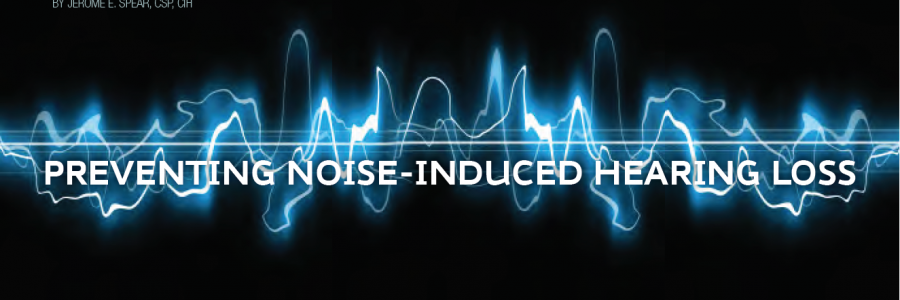
Preventing Noise-Induced Hearing Loss
Noise, or unwanted sound, is a by-product of many industrial processes. Sound consists of pressure changes in a medium (usually air), caused by vibration or turbulence. These pressure changes produce waves emanating away from the turbulent or vibrating source. Exposure to high levels of noise causes hearing loss and may also put stress on other parts of the body. The extent of damage depends primarily on the intensity of the noise and the duration of exposure.
Noise-induced hearing loss can be temporary or permanent. Temporary hearing loss results from short-term exposures to noise, with normal hearing returning after a period of rest. Generally, prolonged exposure to high noise levels over a period of time gradually causes permanent damage. For most effects of noise, there is no cure. Therefore, controlling exposure to excessive noise is the only way to preserve your hearing.
This paper summarizes the potential health effects of noise applicable workplace noise exposure standards and regulations. Noise measuring methods are also described.
HEALTH EFFECTS
The damage done by noise depends mainly on how loud it is and on the duration of exposure. The frequency or pitch can also have some effect since high-pitched sound are more damaging than low-pitched ones.
Noise may tire out the inner ear, causing temporary hearing loss. After a period of time off, hearing may be restored. Some workers who suffer temporary hearing loss may find that by the time their hearing returns to normal, it is time for another work shift, so, in that sense, the problem is “permanent.”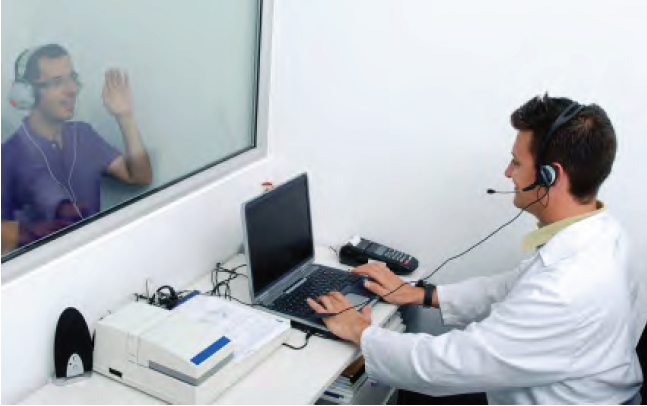
With continual noise exposure, the ear will lose its ability to recover from temporary hearing loss, and the damage will become permanent. Permanent hearing loss results from the destruction of cells in the inner ear – cells which can never be replaced or repaired. Such damage can be caused by long-term exposure to loud noise or, in some cases, by brief exposures to very loud noises.
Normally, workplace noise first affects the ability to hear high frequency (high-pitched) sounds. This means that even though a person can hear some noise, speech or other sounds may be unclear or distorted. A hearing aid can make speech louder, but cannot make it clearer, and is rarely a satisfactory remedy for hearing loss. People suffering from noise-induced hearing loss may also experience continual ringing in their ears, called “tinnitus.”
Although research on the effects of noise is not complete, it appears that noise can cause a quicken pulse rate, increased blood pressure, and a narrowing of the blood vessels. Over a long period of time, these physiological effects may place an added burden on the heart. Noise may also put stress on other parts of the body by causing the abnormal secretion of hormones and tensing of muscles. Workers exposed to noise sometimes complain of nervousness, sleeplessness and fatigue. Excessive noise exposure can also reduce job performance and may cause high rates of absenteeism.
OCCUPATIONAL NOISE STANDARDS AND REGULATIONS
OSHA’s Permissible Exposure Limits (PELs)
OSHA has two regulations for noise – one for construction worksites (29 CFR 1926.52) and one for general industry worksites (29 CFR 1910.95). OSHA’ current Permissible Exposure Limits (PELs) are based on a 5 decibel (5 dB) exchange rate. That means, when the duration of noise exposure is cut in half, the allowable noise exposure is increased by 5 dB. OSHA’s PELs for noise is listed in the following table: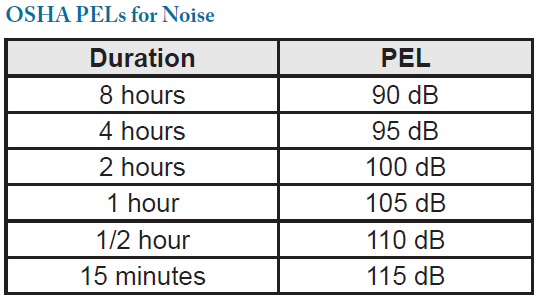
Anything above 115 dB, an employee is not allowed to be exposed to without hearing protection. An employee is not to be exposed to any impact noises in excess of 140 dB without hearing protection. Impact (or impulse) noise is defined as noise that lasts less than 1/2 second and is not repeated more than once per second.
OTHER NOISE STANDARDS

In addition to OSHA’s regulations, there are Recommended Exposure Limits (RELs) established by the National Institute of Occupational Safety and Health (NIOSH) and Threshold Limit Values (TLVs) established by the American Conference for Governmental Industrial Hygienists (ACGIH). The RELs and TLVs are recommended standards and are more protective than OSHA’s PELs. The RELs and TLVs are based on a allowable exposure of 85 dB for an 8-hour period with a 3-dB exchange rate. The RELs and TLVs are provided below.
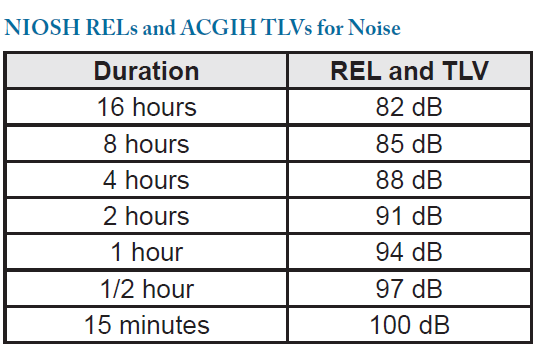
Like the OSHA standard for noise, NIOSH and ACGIH do not allow exposure to continuous, intermittent, or impact noise in excess of peak level of 140 dB without hearing protection.
Hearing Conservation Program – 29 CFR 1926.52 (Construction)
The current OSHA standard for noise in construction stipulates that employees exposed to 90 dB (using the A-weighted network, dBA) for an 8-hour work shift should be included in an effective Hearing Conservation Program(HCP). When noise exposure levels are exceeded according to the appropriate duration, feasible administrative or engineering controls must be used to lower employee noise exposure. If such controls fail to reduce sound to the levels shown in the Table 1, personal protective equipment must be provided and used to reduce noise exposure to within those levels.
Hearing Conservation Program – 29 CFR 1910.95 (General Industry)
The current OSHA standard for noise at general industry worksites stipulates that employees exposed to 85 dBA for an 8-hour work shift be included in an effective Hearing Conservation Program (HCP). For work shifts greater than eight hours, OSHA has no provisions for reducing the noise exposure limit for determining when engineering or administrative controls are required and when mandatory hearing protection is required. However, the Action Level of 85 dBA must be adjusted for work shifts greater than eight hours to account for longer exposure periods and shorter recovery periods. For a 12-hour work shift, the adjusted Action Level is calculated to be 82.1 dBA. Employees with a time-weighted average noise exposure above OSHA’s Action Level must be included in an effective Hearing Conservation Program (HCP), which includes the following elements:Hearing protection must be available but is not mandatory to use.
- Audiometric tests must be performed annually and employees informed of the results.
- Employees who have not yet had their baseline (initial)audiogram must wear hearing protection until their baseline audiogram has been evaluated.
- Employees whose audiograms indicate that a standard threshold shift (of 10 dB or more at 2000, 3000, and4000 hertz in either ear) has occurred must wear hearing protection.
Annually, employees must receive training in the following topics:
- Effects of noise on hearing
- Advantages, fitting, attenuation, selection, use and care of hearing protectors
- Purpose of audiometric testing and explanation of the test procedure
- Noise exposure monitoring must be conducted to evaluate employee exposures for inclusion into a HCP.
- Employees must be notified of noise monitoring results that are representative of their exposure.
- Areas where hearing protection is required must be posted.
- Records must be kept of the noise monitoring and audiometric test results.
When noise exposure exceeds 90 dBA (100 percent of the PEL), employees must wear hearing protectors regardless of their audiometric test results. Such employees must also be included in an effective HCP as outlined above.
NOISE MONITORING
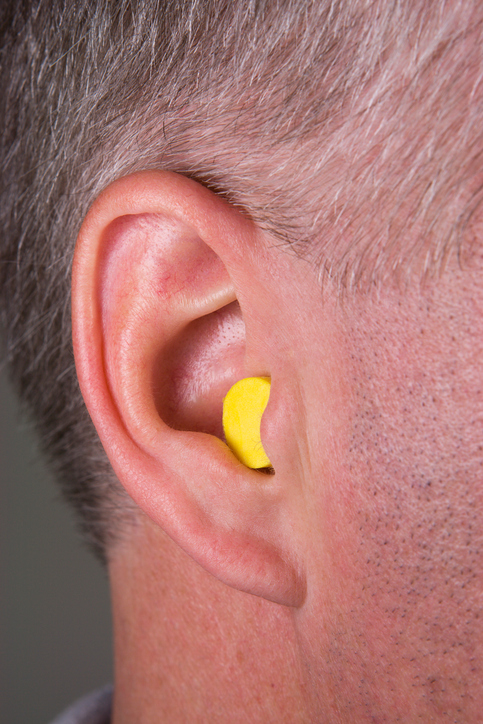 In the workplace, noise can be monitored in different ways depending on the scope and purpose of the noise monitoring survey. If information is needed on the amount of noise an employee is exposed to, personal noise monitoring should be conducted. A personal sampling device, called a noise dosimeter, is typically worn by the employee for approximately the length of the work shift. The microphone in placed at the center of the shoulder. The dosimeter integrates all noise measurement above a specified threshold into an average sound level measurement. Area samples may be taken to identify potential high noise areas and to determine major contributing sources of noise. Area samples are most often conducted using a sound level meter.
In the workplace, noise can be monitored in different ways depending on the scope and purpose of the noise monitoring survey. If information is needed on the amount of noise an employee is exposed to, personal noise monitoring should be conducted. A personal sampling device, called a noise dosimeter, is typically worn by the employee for approximately the length of the work shift. The microphone in placed at the center of the shoulder. The dosimeter integrates all noise measurement above a specified threshold into an average sound level measurement. Area samples may be taken to identify potential high noise areas and to determine major contributing sources of noise. Area samples are most often conducted using a sound level meter.
Dosimeter, as well as sound level meters must have an accuracy of +/- 2 dBA (ANSI Type 2 SLM/Dosimeter). All noise measuring instruments should be calibrated according to the manufacturer’s instructions before and after each day of use and whenever the temperature or relative humidity significantly changes.
NOISE DOSIMETERS
OSHA requires the Threshold Level for noise dosimeters to be set at 80 dBA or 90 dBA, whichever is appropriate for the evaluation. To determine if employees should be included in a HCP, the 80 dBA Threshold should be used. To determine if the PEL is exceeded, the 90 dBA Threshold should be used.
Dosimeters give results as a percent dose, average(Lavg), and/or time-weighted average. Most dosimeters are capable of simultaneously measuring Lavg, TWA, and percent dose at multiple Threshold Levels, Criterion Levels, and/or Exchange Rates.
Dosimeters are capable of measuring in Lavg and TWA. Lavg is the average sound level based on the actual time measured. For example, if the dosimeter was worn for three hours, then the average is based on the reading during those three hours. Lavg is useful for short-term samples and for making projections such as when full-shift measurements cannot be taken. TWA is always the 8-hour time weighted average regardless of the sample duration. That is, if the sample time is 8 hours, Lavg and TWA would be equal. The TWA noise reading is directly compared to OSHA’s 8-hour PEL and/or Action Level.
SOUND LEVEL METERS (SLM)
Sound level meters (SLM) provide instantaneous sound level readings. Some SLMs will data log the different readings that were taken during a sampling period. SLMs are used mostly for area monitoring and are used for these five purposes:
- To spot-check noise dosimeter performance;
- To determine an employee’s noise dose whenever a noise dosimeter is unavailable or inappropriate;
- To identify and evaluate individual noise sources for abatement purposes;
- To aid in the determination of the feasibility of engineering controls for individual noise sources for abatement purposes; and/or
- To evaluate hearing protectors.
OCTAVE BAND ANALYZER
Noise is a mixture of sound levels at various frequencies. Therefore, noise is measured using one of the standard weighting networks – weighting scale “A”, “B”, or “C”. These three frequency filters cover the frequency range of the human ear (20 to 20,000 Hertz). Sound comes in different frequencies and the human ear is more responsive to certain scales of frequency. When sampling is performed, weighting filters capture the frequencies that will replicate the auditory response of the ear. The “A” scale has lower frequencies discounted to some degree and most closely resembles the response of the human ear. The “A” weighting network is most commonly used in industrial and community noise applications and is measured as dBA. Weighting filters for the “A” scale attempt to respond similarly to the way the human ear responds, thus, standards are written according to measurements in dBA. The “B” weighting network follows the frequency sensitivity of the human ear at moderate levels. It was used in the past for predicting performance of loudspeakers and stereos, but not industrial noise. The “C” weighting network, attempts to represent how the ear perceives sound at high decibels and provides a fairly flat response with only slight attenuation of the very high and very low frequencies.
In order to implement engineering controls to reduce the overall noise levels, the acoustical engineer must know the predominant frequency of each prior noise source. An octave band analyzer consists of a sound level meter with an octave band filter set. This allows the noise to be measured at various octave bands. The results of the analyzed data indicate those octave bands that contain the majority of the total radiated sound power. To determine what kind of engineering controls to use, it is necessary to know in detail the frequencies of the noise since various materials attenuate sound differently depending on the frequency. Some noise control materials are designed for low frequency attenuation, whereas some materials attenuate high frequencies.
CONCLUSION
Noise is frequently present above allowable exposure limits at construction and general industry work sites. Noise can have both auditory and non-auditory health effects. There is no cure for noise-induced hearing loss. Therefore, prevention of excessive noise exposure is the only way to preserve your hearing. In general, implementing feasible engineering controls should be considered when noise monitoring indicates that the levels are excessive. Administrative controls and/or personal protective equipment (such as hearing protection devices) should be used when engineering controls are not feasible or sufficient to reduce exposures below allowable levels.

